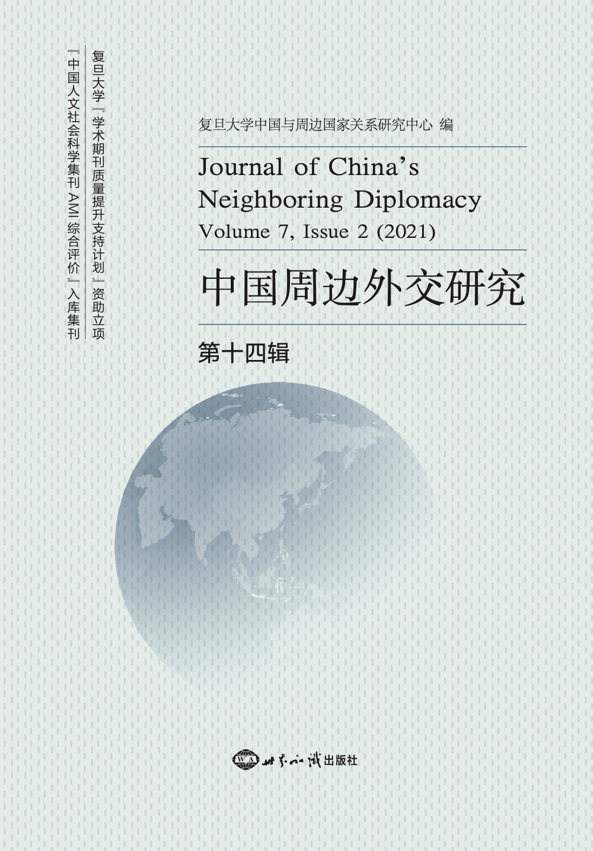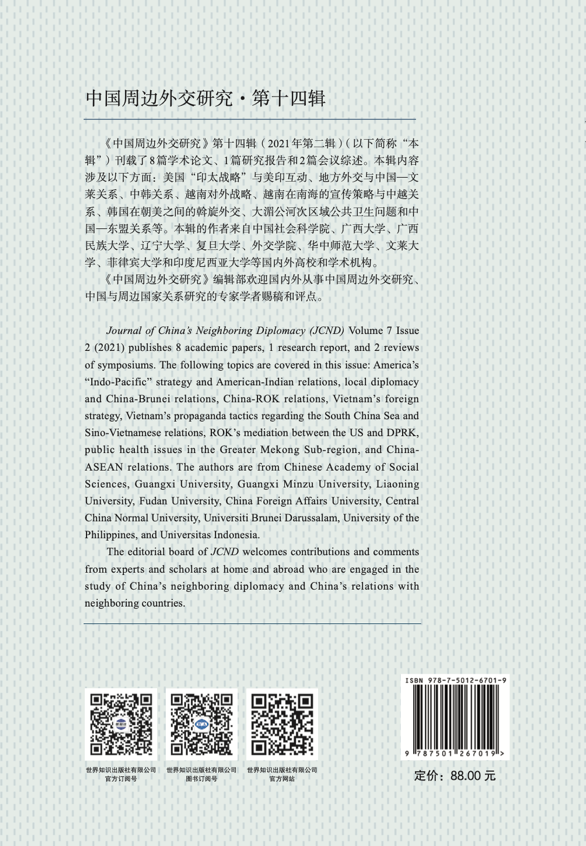|
|
The Title Page of Journal of China's Neighboring Diplomacy, Vol. 7, Issue 2 (2021) | The Back Cover of Journal of China's Neighboring Diplomacy, Vol. 7, Issue 2 (2021) |
Center for China’s Relations with Neighboring Countries of Fudan University (CCRNC Fudan), ed., Journal of China's Neighboring Diplomacy, Vol. 7, Issue 2, 2021.
Publisher: World Affairs Press (China)
Published in December 2023.
ISBN: 978-7-5012-6701-9
Contents
Preface...... ZHAO Weihua / 1
Situation of Neighborhood
U.S. Indo-Pacific Strategy, “China Factor” and U.S.-India Interaction...... YANG Xiaoping / 11
Research on China’s Relations with Neighboring Countries
The Role and Prospect of Local Diplomacy in China-Brunei Cooperation...... LUO Chuanyu and ZHI Pengyu / 33
A Missing “Honeymoon”: The Influence of Structural Misperception on Strategic Instability between China and Its Neighboring Countries—A Case Study of China-ROK Relations in 2016–2017...... FANG Jiongsheng / 51
Research on Neighboring Countries
Analysis of Vietnam’s Foreign Strategy and Policy Direction in the Context of the Great Change...... GU Qiang and HUANG Jian / 81
Research on the Hedging of Vietnam’s Strategy towards China from Vietnam’s Propaganda on the South China Sea Disputes...... YANG Yang / 104
A Study on ROK’s Mediation Role in the New Development of DPRK-US Relations—Take the Moon Jae-in Administration’s Mediation in Its Early Years as an Example...... LI Jiacheng and ZHANG Yiliang / 121
Regional Issues under the COVID-19 Pandemic
Trade Linkages and Supply Chains Resilience: Navigating the COVID‐19 New Normal (excerpt) ...... NACAI scholars / 151
The Diffusion of Public Health Policies in the Greater Mekong Subregion: A Perspective of Practice Theory...... YANG Jiayi / 180
China’s Neighboring Diplomacy
Thirty Years of China–ASEAN Relations and the Development of China’s Neighboring Diplomacy...... GUO Zhiben / 205
Reviews on Symposiums
Review on the Eleventh Fudan Symposium on China’s Neighboring Diplomacy...... ZHANG Ting / 229
Review on the Fifth NACAI International Symposium...... ZHANG Zeyu / 238
Appendix
Introduction on Center for China’s Relations with Neighboring Countries of Fudan University (CCRNC Fudan)...... / 247
Notice Inviting Contributions to the Journal of China’s Neighboring Diplomacy...... / 249
Standards of Articles and Annotations of the Journal of China’s Neigh‐ boring Diplomacy...... / 251
Acknowledgements to Reviewers...... / 256
U.S. Indo-Pacific Strategy, “China Factor” and U.S.-India Interaction
YANG Xiaoping
Abstract The basic logic of the U.S. Indo-Pacific strategy is to achieve the balance of power in the Indo-Pacific region by “arming” India. In terms of the strategic positioning of India, the United States is caught between a “swing state” and a “leading state”, which makes the U.S.-India strategic relationship inherently limited. In terms of India’s feedback to the U.S. Indo-Pacific strategy, it has mainly followed a “reactive” strategy at different stages while taking into account the “China factor”. This includes a wait-and-see period for G2 concerns and a “cautiously proactive” strategic mix during the debugging period. The U.S.-India strategic interaction is strongly driven by the “China factor” and follows the logic of “U.S.-led, India-amended”. This brings two results: first, the direction of the evolution of the U.S. Indo-Pacific strategy determines the general framework of U.S.-India strategic cooperation; second, India’s judgment of “opportunities” in the context of U.S.-China strategic competition will, to some extent, determine the effectiveness of the implementation of the U.S. Indo-Pacific strategy. As a weak party, India tries to implement a “tricky pry” between China and the United States, so that the U.S.-India interaction based on the “China factor” has the potential to form a “China-U.S.-India” closed-loop interaction.
Keywords Indo-Pacific strategy; China factor; U.S.-India interaction; cognitive feedback; interaction logic
Author YANG Xiaoping, associate professor at Research Office of China’s Periphery and Global Strategy, National Institute for Global Strategy, Chinese Academy of Social Sciences.
![]() 1. 杨晓萍:美国“印太战略”、“中国因素”与美印互动.pdf
1. 杨晓萍:美国“印太战略”、“中国因素”与美印互动.pdf
The Role and Prospect of Local Diplomacy in China-Brunei Cooperation
LUO Chuanyu and ZHI Pengyu
Abstract With the promotion of “the Belt and Road” construction, local governments have increasingly become a very active subject in China’s foreign exchanges. Due to the differences between China and Brunei, local diplomacy can play a very important role in cooperation between the two sides. There are four levels of local diplomacy in China Brunei Cooperation, whose main body is clear, the development process is gradual, and a comparison has been formed between economic, trade, humanities and political mutual trust. Based on the analysis of internal causes, this paper points out that the local diplomacy’s subjects are diverse, the inclusiveness and results are fruitful, which not only promote the establishment of close relations between the two sides, but also strengthen the confidence of both sides in participating in regional cooperation. In combination with the existing shortcomings, local diplomacy should increase policy communication frequency in terms of system design, adjust economic cooperation strategies, and Strengthen non-governmental diplomacy, to promote the deepening and specialization of strategic cooperative partnership.
Keywords Brunei Darussalam; local diplomacy; economic corridor
Funding This paper is a study on “Legal risks and responses of Chinese enterprises’ investment in Southeast Asian countries in the context of deepening the construction of ‘the Belt and Road’” (No. 2020QGRW003), a humanities project under the “Guangxi Higher Education Department’s Thousands of Backbone Teachers Training Program”.
Authors LUO Chuanyu, associate professor of China-ASEAN Research Institute, Guanxi University; Zhi Pengyu, Ph. D Candidate of the School of Business, Guangxi University.
![]() 2. 罗传钰、支鹏宇:地方外交在中国—文莱合作中的角色与展望.pdf
2. 罗传钰、支鹏宇:地方外交在中国—文莱合作中的角色与展望.pdf
A Missing “Honeymoon”: The Influence of Structural Misperception on Strategic Instability between China and Its Neighboring Countries —A Case Study of China-ROK Relations in 2016–2017
FANG Jiongsheng
Abstract Strategic instability poses deep challenge to China’s neighborhood diplomacy, and the most severe type happens when the bilateral relation is developing smoothly, and the two sides do not have enough anticipation. This article tries to argue that structural misperception brought about by asymmetric structure between countries is the important reason for the outbreak of such strategic instability without anticipation. In the asymmetric structure, the large country and the small country have different level of attention towards each other. This “attention gap” further causes the difference on the two countries’ degrees of emotional fluctuation and means of information processing when facing bilateral relation, and in the end leads to the over-optimistic or over-pessimistic misperceptions of the small country. Case study of China-ROK relations shows that the ROK decision- makers are over-optimistic during the China-ROK “Honeymoon”, overconfidently viewing the influence of the improvement of China-ROK relations, while unable to distinguish the core information of Chinese alert. These leads to the speculation of ROK government that harms Chinese interest. And when China-ROK relations deteriorate, ROK decision-makers are over-pessimistic, regarding that the conflict with China will harm its autonomy and safety of its people, and exaggerating the extent of Chinese counterattack. These misperceptions finally result in severe strategic instability. The key for assuring sustainable and stable development of the relations between China and its neighboring countries is to build a fundamental consensus of mutual trust on each other’s positive intention.
Keywords structural misperception; strategic instability; neighboring diplomacy; China-ROK relations
Author FANG Jiongsheng, Ph. D Candidate of the School of International Relations and Public Affairs, Fudan University.
![]() 3. 方炯升:失落的“蜜月”:结构性错误知觉对中国周边战略失稳的影响——以2016—2017年中韩关系为例.pdf
3. 方炯升:失落的“蜜月”:结构性错误知觉对中国周边战略失稳的影响——以2016—2017年中韩关系为例.pdf
Analysis of Vietnam’s Foreign Strategy and Policy Direction in the Context of the Great Change
GU Qiang and HUANG Jian
Abstract In the context of the Great Change, the proper handling of China- Vietnam relations has become an important task for China’s diplomacy. Therefore, it is of special significance to study and explore Vietnam’s foreign strategy and policy direction, especially its policy toward China, in the context of the Great Change. The Great Change, unprecedented in a century, has presented many features in terms of economy, science and technology, international pattern and development model. Vietnam believes that the Great Change has brought positive and negative impacts. On the one hand, it has brought Vietnam a great historical opportunity, which can be described as a “once-in-a-millennium opportunity”. On the other hand, it has also brought many challenges to Vietnam, mainly the compression of choice space, the challenge by reorganization of order and the uncertainty caused by the Great Change. In the context of the Great Transformation, Vietnam’s policy goal is to achieve parity with the five continental powers, the policy environment is a more favorable international environment than ever before, and the policy measures are to adopt a “mixed approach” to cope with it. Against the backdrop of major changes, Vietnam will maintain a non-selective stance and maintain a dynamic balance between China and the United States, while actively promoting “multilateral and diversified” diplomacy. Economic diplomacy will become the top priority of Vietnam’s diplomacy in view of the country’s development goals, and Vietnam’s further integration into the international community will not change.
Keywords the Great Change; Vietnam; foreign strategy; policy direction
Funding Phase outcome of “Research on the Cognition and Policy Choice of ASEAN Countries to Sino-US Strategic Competition” (No. 20XGJ013) funded by National Social Science Fund of China.
Authors GU Qiang, Associate Professor at School of Marxism, Guangxi University; HUANG Jian, Graduate Student at School of Marxism, Guangxi University.
![]() 4. 顾强、黄坚:大变局背景下越南的对外战略与政策走向探析.pdf
4. 顾强、黄坚:大变局背景下越南的对外战略与政策走向探析.pdf
Research on the Hedging of Vietnam’s Strategy towards China from Vietnam’s Propaganda on the South China Sea Disputes
YANG Yang
Abstract As the changes in the situation of East Asia and strength comparison of major countries, Vietnam has been keeping on political and economic cooperation with China while continually advancing the security collaboration with countries like the US with an eye on balancing China. By research on Vietnam’s propaganda on the South China Sea disputes in 2019 and 2020, it can be judged that Vietnam’s strategy towards China is hedging geopolitical risk. Vietnam has a strong but not extreme sense of risk, and its strategy mainly includes indirect balancing and comprehensive betting. This strategy has hindered the development of Sino-Vietnamese relations, but it is also restricted by the bilateral cooperation mechanism between the two countries. Besides, it is basically consistent with the proposition of multilateralism reflected in the ASEAN Indo-Pacific Outlook, and to some extent useful to strengthen the centrality of the ASEAN community and the stability of Southeast Asia.
Keywords Vietnam; the South China Sea; propaganda; hedging
Author YANG Yang, associate professor of Guangxi University for Nationalities, researcher of College of ASEAN Studies.
![]() 5. 阳阳:从越南涉南海话语宣传看越南对华策略的对冲性.pdf
5. 阳阳:从越南涉南海话语宣传看越南对华策略的对冲性.pdf
A Study on ROK’s Mediation Role in the New Development of DPRK-US Relations —Take the Moon Jae-in Administration’s Mediation in Its Early Years as an Example
LI Jiacheng and ZHANG Yiliang
Abstract Mediation is an ancient topic. Although mediation is very common, there is still room for further improvement in the theoretical study of mediation. Through empirical research, scholars such as Jacob Bercovitch and Qi Haixia have summarized the factors affecting the effectiveness of mediation, classified mediation strategies, explored the nature of caucusing models and joint models of mediation, and built contingency models of mediation. Although ROK’s mediation faces some difficulties, it has an obvious effect on the development of DPRK-US relations, especially in the revival of the first Kim-Trump Summit. ROK even calls itself “the peninsula pilot”. ROK’s mediation has three positive functions, such as serving as a messenger between the DPRK and the US. Meanwhile, there are two limitations for ROK’s mediation, namely, less leeway and inability to control the final decision. ROK is not the decisive factor influencing the mediation between the DPRK and the US and cannot do anything beyond the scope of its own mediation. Therefore, ROK needs to see its status and role realistically, and it is necessary for ROK to fully cooperate with major regional powers and follow the mediation path of “firstly caucusing and then joint” to form the resultant force of mediation, which leads to the success of mediation between DPRK and the US.
Keywords mediation; ROK; the Moon Jae-in administration; DPRK-US relations; the Korean peninsula issue
Authors LI Jiacheng, associate professor of School of International Economics and International Relations, Liaoning University; ZHANG Yiliang, Doctoral Candidate, Northeast Asia College, Shandong University.
![]() 6. 李家成、张翊梁:论韩国在朝美之间的斡旋外交——以文在寅政府执政前期的斡旋为例.pdf
6. 李家成、张翊梁:论韩国在朝美之间的斡旋外交——以文在寅政府执政前期的斡旋为例.pdf
Trade Linkages and Supply Chains Resilience: Navigating the COVID‐19 New Normal (excerpts)
NACAI scholars
Abstract On October 16, 2021, Network of ASEAN-China Academic Institutes (NACAI) and the University of Brunei jointly released a research report on “Trade linkages and supply chains resilience: Navigating the COVID-19 new normal”, which focuses on the value chain and discusses the impact of the COVID-19 on intra-regional economic and trade activities from multiple perspectives. The report is also one of the outcomes of NACAI international symposium, with six authors from renowned research institutions in China, Brunei, Philippines, Indonesia, Singapore and Vietnam. This journal included the Chinese version of four essays in the report.
Keywords trade; supply chain; COVID-19; East Asia regional cooperation; ASEAN
Funding This report was funded by a grant of the Office of Global Partnerships (Key Projects Development Fund) of Fudan University.
Authors HE Ping, Professor, Center for Japanese Studies, Institute of International Studies, Fudan University; Bruno Jetin, Associate Professor, Institute of Asian Studies, Universiti Brunei Darussalam; Henelito A. Sevilla, Jr, Associate Professor, Asian Center, University of the Philippines Diliman; Shofwan Al Banna Choiruzzad, Ph. D, ASEAN Study Center, Universitas Indonesia.
Translator ZHANG Zeyu, Scientific Secretary, Center for China’s Relations with Neighboring Countries, Fudan University.
Proofreader WEN Yao, Assistant Professor, China’s Relations with Neighboring Countries, Fudan University.
Declaimer The views and opinions expressed within this cooperative research report are those of the authors and do not necessarily reflect the official policy or position of their home governments.
![]() 7. 中国—东盟学术共同体学者:《贸易联系与供应链韧性:应对新冠疫情新常态》(节选).pdf
7. 中国—东盟学术共同体学者:《贸易联系与供应链韧性:应对新冠疫情新常态》(节选).pdf
The Diffusion of Public Health Policies in the Greater Mekong Subregion: A Perspective of Practice Theory
YANG Jiayi
Abstract The countries in the Greater Mekong Subregion have tried to promote regional public health governance since 1990s and formed a community of practice. Cooperation and coordination among regional countries in public health has achieved progress and contributed to the fight with COVID-19. The current literature shows that it is hard to take coordinated actions in the Greater Mekong Subregion and policy diffusion in the field of public health is rare. However, this paper argues that regional countries have formed the common background knowledge with development as the key consideration and built up a consensus of valuing health security and economic growth at the same time. As a result, the six countries are willing to cooperate with each other and move forward with coordinated public health policies. By doing so, international diffusion of effective public health policies has occurred in the region.
Keywords the Greater Mekong Subregion; public health; policy diffusion; practice theory
Author YANG Jiayi, editor of Foreign Affairs Review, Ph. D degree received from China Foreign Affairs University.
![]() 8. 杨嘉宜:大湄公河次区域公共卫生政策的扩散——基于实践理论的视角.pdf
8. 杨嘉宜:大湄公河次区域公共卫生政策的扩散——基于实践理论的视角.pdf
Thirty Years of China–ASEAN Relations and the Development of China’s Neighboring Diplomacy
GUO Zhiben
Abstract Since the establishment of dialogue relations in 1991, China- ASEAN cooperation has been expanding in areas, enriching in content and bringing more and more achievements. The relations between China and ASEAN are becoming more and more mature and an important pillar in maintaining regional peace and stability and promoting prosperity and development. A summary of the diplomatic interaction of China and ASEAN in the past 30 years shows that the development of bilateral relations has played an important role in promoting China’s neighborhood diplomacy. To be specific, the friendlier political relations, deeper economic cooperation and closer social and people-to-people ties between China and ASEAN have charted the course for China’s neighboring diplomacy. China’s efforts to train diplomatic teams, provide public goods and carry out international communication in ASEAN have provided opportunities for China to build its neighboring diplomacy capacity. China and ASEAN are committed to peaceful coexistence and good-neighborliness, and our joint efforts to uphold and practice multilateralism have created a prerequisite for the innovation of China’s neighboring diplomacy. As the socialism with Chinese characteristics has entered the new era, keeping pace with the times and working hard to develop China-ASEAN relations has become an integral part of China’s neighboring diplomacy. As China-ASEAN relations have entered a new stage of all-round development, we have adopted a diplomatic strategy with Chinese characteristics, style and manner for our neighbors and enriched the theoretical system of major-country diplomacy with Chinese characteristics.
Keywords ASEAN; neighboring diplomacy; China-ASEAN relations; China’s diplomacy
Author GUO Zhiben, Doctoral Candidate of Central China Normal University.
![]() 9. 郭志奔:中国—东盟关系 30 年与中国周边外交发展.pdf
9. 郭志奔:中国—东盟关系 30 年与中国周边外交发展.pdf








